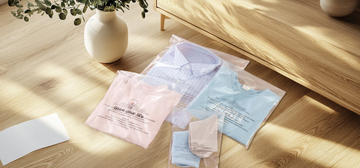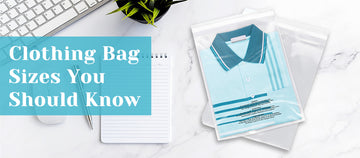In eCommerce, presenting your clothing products professionally and efficiently is an important advantage that enhances the shopping experience for customers and builds trust in your brand. One of the most critical yet often overlooked aspects of product presentation is the packaging. Clear cellophane bags have emerged as a popular choice for clothing sellers due to their cost-effectiveness, transparency, and ability to protect garments during storage and shipping. Whether you're selling lightweight summer outfits or bulky winter coats, choosing the right cellophane bag is essential for maintaining product integrity and enhancing the customer experience.
How to Measure Your Clothing Products
Measuring clothing dimensions accurately is the foundation of selecting the correct clear cellophane bag size. It ensures a snug fit, protects the garment during transit, and presents a professional appearance to customers. To start, fold the product into the shape it will take during shipping. This is crucial because packaging dimensions depend heavily on the way the item is arranged for transport. Once folded, measure the length, width, and depth (thickness) of the item in sequence.
It’s important to note that clothing dimensions vary with seasonal garments. Lightweight summer clothes are usually thinner and require smaller bags, while heavier winter garments often need larger, more accommodating bags. Even within the same season, materials differ—some fabrics are soft and voluminous but compressible, while others are dense and resistant to compression. These characteristics must be taken into account when determining the right bag size.
Prepare the Clothing: Lay the garment flat on a clean, even surface. Ensure the item is buttoned, zipped, or neatly folded into the shape it will take during shipping. This is particularly important for bulkier items, such as winter coats, as compact folding minimizes space and provides a clear reference for measurement.
Measure the Dimensions: Use a measuring tape or ruler to capture the three critical dimensions:
- Length: Measure the longest side of the folded garment.
- Width: Measure across the widest point of the item when folded.
- Thickness (Depth): Measure the height of the folded garment to account for its bulk.
Add a Buffer: Once you have the dimensions, add 1-2 inches to each side. This extra space allows for easy insertion of the clothing into the bag and accommodates any sealing mechanisms, such as adhesive strips.
For example, a folded T-shirt measuring 8 inches in width, 10 inches in length, and 1 inch in thickness would fit perfectly in a 10” x 13” clear cellophane bag. Similarly, a winter coat measuring 12 inches wide, 18 inches long, and 3 inches thick might require a 14” x 20” bag to ensure adequate space without squeezing the garment.

By following these steps, you can ensure that your measurements are accurate, leading to better bag selection and a more professional presentation for your customers. Additionally, we strongly recommend that you purchase a small quantity of bags for testing
before finalizing the size and proceeding with bulk ordering.
How to Choose the Right Bag
Selecting the appropriate clear cellophane bag is more than just matching dimensions; it involves several key considerations to ensure the packaging aligns with your product’s needs, platform requirements, and customer expectations. Here’s what you need to evaluate:
-
Bag Size:
Start by matching the bag size to your clothing’s dimensions after folding. Remember to leave a little extra room—1-2inches on each side—for easy insertion and sealing. For example, winter coats might need larger bags, while lightweight summer tops fit comfortably in smaller ones. To simplify the process, we’ve included size recommendations for different types of clothing in winter at the end of this section. -
Bag Thickness:
The thickness of the bag determines its strength. For heavier or bulkier items, thicker bags (around 2 mils or more) are more durable. For lightweight clothing, thinner bags (1–1.5 mils) work well while maintaining clarity. Select the thickness based on your product needs to achieve the perfect balance between durability and cost. -
Cost Effectiveness:
Cost is always a factor, especially for bulk orders. Look for high-quality suppliers offering durable bags at competitive prices. It’s wise to test a small batch of bags first to ensure they meet your standards before committing to bulk purchases. This practice minimizes waste and ensures a consistent packaging experience. -
Environmentally Friendly Options:
In today’s environmentally conscious market, using eco-friendly packaging is not just a preference but often a necessity. Opt for recyclable or biodegradable clear cellophane bags to align with customer expectations and comply with growing environmental regulations. -
Waterproof Design:
Waterproof bags are essential to protect clothing during transit or storage, especially in damp or unpredictable weather. This feature ensures that your garments stay clean and dry, giving customers peace of mind about the quality and care you put into your packaging. -
Easy to Seal:
The ease of sealing impacts both your packing efficiency and your customer’s unboxing experience. Bags with adhesive strips, zip locks, or self-sealoptions can streamline the packing process, saving you time while ensuring the packaging remains secure. Customers appreciate packaging that is easy to open yet durable enough to protect the product. -
Transparency:
High transparency is a valuable feature for showcasing your products. Clear bags allow customers to see the clothing’s quality and design without opening the packaging, making it an excellent choice for eCommerce sellers focused on presentation.
By considering these factors, you can select cellophane bags that not only meet your product needs but also enhance the overall customer experience.
Common Bag Sizes for Winter Clothes
|
Category |
Item Examples |
Common Bag Sizes |
|
Outerwear |
Medium Coats, Jackets |
|
|
|
Heavy Overcoats, Parkas |
|
|
|
Children’s Winter Coats |
|
|
|
Extra-Large or Custom Coats |
24” x 32”, 30” x 36” |
|
Base Layers |
Single Thermal Tops/Bottoms |
|
|
|
Thermal Sets |
|
|
|
Children’s Thermals |
|
|
Bottoms |
Lightweight Trousers, Skirts |
|
|
|
Denim Jeans, Lined Pants |
14” x 18” |
|
|
Children’s Bottoms |
|
|
Accessories |
Gloves, Socks (Single Pair) |
|
|
|
Scarves, Hats |
|
|
|
Accessory Bundles |
|
|
Indoor Winter Wear |
Single Pajama Sets |
|
|
|
Warm Homewear |
18” x 24” |
|
|
Slippers |
What If I’m an Amazon Seller?
If you’re selling on Amazon, there are additional packaging requirements to keep in mind. Following these guidelines ensures compliance with Amazon’s policies and provides a professional presentation for your products:
-
Minimum Bag Thickness:
Amazon requires poly bags to have a minimum thickness of 5 mil. This ensures durability and reduces the risk of tears or damage during handling and shipping. -
Suffocation Warning:
For poly bags with a 5-inch opening or larger(measured when flat), a suffocation warning must be included. This warning can either be printed directly on the bag or attached as a label. Ensuring this detail is in place helps you meet safety standards and avoid compliance issues. -
Bag Margins and Fit:
The poly bag or shrink wrap must not extend more than 3 inches beyond the dimensions of the producton any side. This guideline not only meets Amazon’s requirements but also ensures your packaging appears neat and professional. Oversized bags can lead to unnecessary material waste, increased costs, and a less polished presentation. -
Sealing Scented Products:
For products with strong scents, such as candles, incense, or pet items like bully sticks, Amazon requires that they be sealed or bagged. This prevents the scent from transferring to other products during storage or shipping. Failing to meet this standard could result in product returns or repackaging, leading to additional time and costs.
By adhering to these Amazon-specific requirements, you can avoid penalties, improve your product’s presentation, and provide a seamless customer experience. Packaging not only protects your product but also reflects your brand’s professionalism, which is essential for success on platforms like Amazon.
Conclusion
Choosing the right clear cellophane bags for your clothing products is a small but important step in building a professional and efficient eCommerce operation. From accurate measurements to selecting eco-friendly, waterproof, and compliant packaging, every detail matters. If you're an Amazon seller, adhering to platform-specific guidelines ensures smooth operations and enhances customer satisfaction. By taking the time to find the perfect fit for your products, you not only protect your garments but also elevate your brand image. A well-packaged product speaks volumes about your attention to detail and commitment to quality—both of which your customers will notice and appreciate.
FAQ
What is the best packaging for shipping clothes?
Poly mailers are an excellent choice for shipping clothing. They are lightweight, cost-effective, and provide adequate protection while using less material compared to traditional packaging, which helps reduce shipping costs. Unlike protective inner packaging bags, such as the ones mentioned in this article, poly mailers can be used directly for shipping.
Can clothes be packed in plastic bags?
Yes, clothes can be packed in plastic bags, but these bags should not be used directly for shipping. A sturdy outer layer, such as a poly mailer, is necessary to ensure protection during transit. Generally, to save on costs, boxes are not required for shipping clothing; poly mailers are sufficient for this purpose.





